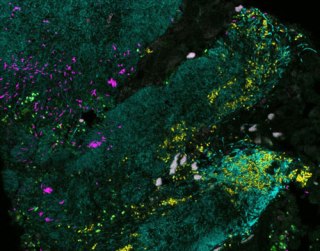Dec 15 2014
Since the first “catalog” of the normal bacterial makeup of the human body was published in 2012, numerous connections between illness and disturbances in the human microbiota have been found. This week, scientists report yet another: Cancerous tumors in the ascending colon (the part nearest to the small intestine) are characterized by biofilms, which are dense clumps of bacterial cells encased in a self-produced matrix.
 Bacteria forming a mixed biofilm on colon cancer tissue. Credit: Jessica Mark Welch, Blair Rossetti, and Christine Dejea.
Bacteria forming a mixed biofilm on colon cancer tissue. Credit: Jessica Mark Welch, Blair Rossetti, and Christine Dejea.
“This is the first time that biofilms have been shown to be associated with colon cancer, to our knowledge,” says co-author Jessica Mark Welch, a scientist at the Marine Biological Laboratory (MBL) in Woods Hole, Mass.
The discovery, led by researchers at the Johns Hopkins Medical Institutions, draws on a novel way to “see” microbial community structure that was developed by Mark Welch and colleagues at the MBL. Called combinatorial imaging, it could potentially be used to clinically diagnose pre-cancerous and cancerous conditions in the ascending colon.
In healthy people, the colon is covered in a mucus layer (mucosa) that helps keep bacteria away from the colon’s “skin,” or epithelia. Remarkably, the team found that colon cancer patients who have tumor-associated biofilms also have biofilms on tumor-free areas of the nearby mucosa.
“This suggests that either the tumor allows the biofilm to form, or the biofilm is helping to cause the tumor,” says Mark Welch. “The breaching of the mucus layer could allow bacteria to come into contact with the host epithelial cells, and that is one thing that could lead to cancer.”
The team found that tumors in the descending colon (going to the rectum) do not have associated biofilms.
Mark Welch and MBL co-authors Gary Borisy (now at the Forsyth Institute) and Blair Rossetti are among a group of MBL scientists who invented the combinatorial imaging technique used in this research. Different colors of fluorescent probes (nine in this study) “light up” different species of bacteria in the biofilm, revealing the 3-D structure of its microbial community. They found that the biofilms associated with ascending colon tumors are composed of many species of bacteria; they are diverse (non-identical); and that the part of the biofilm that invades the mucosal layer contains a subset of all the bacterial strains in the biofilm, rather than just one invading strain.
Citation:
Dejea CM et al (2014) Microbiota organization is a distinct feature of proximal colorectal cancers. PNAS: doi: 10.1073/pnas.1406199111.